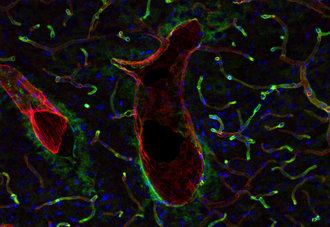
| Cat. No. 161 011 |
100 µg purified IgG, lyophilized. Albumin and azide were added for stabilization. For reconstitution add 100 µl H2O to get a 1mg/ml solution in PBS. Then aliquot and store at -20°C to -80°C until use. Antibodies should be stored at +4°C when still lyophilized. Do not freeze! |
| Applications | |
| Clone | SY-177E4 |
| Subtype | IgG2b (κ light chain) |
| Immunogen | Recombinant protein corresponding to cytoplasatic domain of mouse Caveolin1 (UniProt Id: P49817) |
| Reactivity |
Reacts with: mouse (P49817), rat (P41350), human (Q03135). Other species not tested yet. |
| Remarks |
ICC: Methanol fixation is recommended. |
| Data sheet | 161_011.pdf |

Caveolae are distinct flask shaped invaginations which contain high concentrations of cholesterol and sphingolipids. These subcellular compartments can be found at the surface of many cell types. The primary structural proteins of caveolae are caveolins, a family comprising three members: caveolin1, caveolin2, and caveolin3. Caveolin1 exists in two isoforms, caveolin1α and caveolin1β, which differ in their N-terminal sequences. Caveolin1 is ubiquitously expressed in all cell types and is the predominant coat protein of endothelial caveolae. Caveolin1 is essential in multiple cellular processes, including membrane trafficking, cholesterol homeostasis, signal transduction, and cellular communication (1). Knockout studies have demonstrated that the absence of caveolin1 leads to a complete loss of caveolae structures in various cell types, underscoring its essential role in caveolae formation (2). Its dysregulation has been implicated in cardiovascular diseases, neurodegenerative disorders, metabolic diseases, and cancer (3). Caveolin1 plays a complex role in glioblastoma (GBM), the most aggressive primary brain tumor. Its function in GBM appears to be context-dependent, exhibiting both tumor-promoting and tumor-suppressing activities (4).